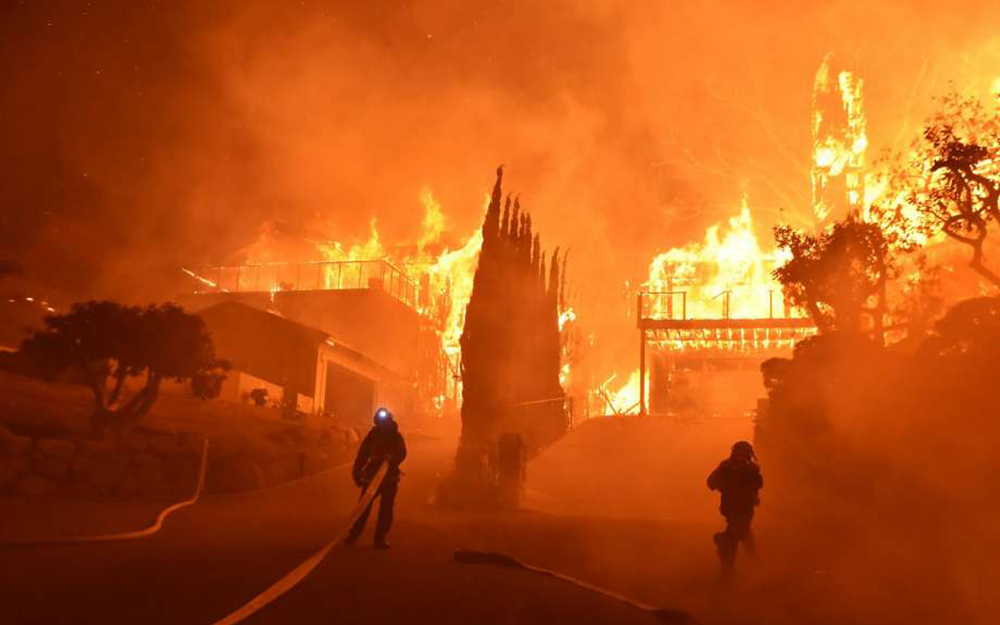
By Haddon Libby
With fires consuming hundreds of thousands of acres and engulfing nearly 1,000 structures, the ferocity of this season’s fires in Southern California seem like something out of a movie. By the time that all of the embers of the current fires have been extinguished, these fires will have become the second or third worst in California history. If we look at all of the fires that have struck California this season, we have seen more destruction this autumn than any other in California’s history. The National Interagency Fire Center has kept track on the destruction caused by wildfires in California since 2000. On average, 8,116 fires occur each year and consuming 645,000 acres.
For comparison, the largest fire to strike Riverside County was the 2013 Mountain Fires near the junction of Highways 74 and 243 where 25,500 acres and 23 structures were consumed.
The worst fire in California happened only fourteen years ago in San Diego County. Called the Cedar fire, 273,246 acres burned consuming 2,820 structures while killing 15 people.
The Tubbs fires of two months ago in Sonoma County was more destructive than the current fires or the Cedar fire as 5,643 structures were destroyed with 22 people killed in this 37,000 acre blaze.
While those fires may be the largest to occur here in California, historians believe that the Great Fire of Meireki in the Japanese capital of Edo back in 1657 was the worst fire ever recorded. More than 100,000 people died while two-thirds of the capital was consumed during the three-day fire.
The worst man-made fires were in 1922 in what is now known as Izmir, Turkey. Originally the Greek city of Smyra, the Turkish and the Greeks fought over this town from 1919 and 1922. Prior to the wars, Smyra was one of Europe’s wealthiest cities. Beginning in 1914 and continuing through 1922, the Turks were actively engaged in an ethnic cleansing of Greeks and Armenians while fighting for control of Smyra. Once the Turks gained control of the city in 1922, a nine-day genocide killed 100,000 Greeks and Armenians as Turkish forces burned homes and businesses.
Another historically large fire was the Great Fire of Rome that occurred in 64 AD. Much like the fires experienced in Southern California, these fires were stoked by strong winds and dry conditions. These fires were the worst to strike Roman antiquities and lasted six days. While many believe that Nero fiddled while Rome burned, that is folklore and did not happen.
Closer to home, the Midwest faced a series of fires similar to our current fires back in 1871. The Great Michigan Fire killed an estimated 2,000 people and burned 2.5 million acres. This fire occurred at the same time as the Great Chicago Fire which killed 300 and burned 3.3 square miles of the city. Many believed that the widespread fires that hit the Midwest at that time were due to a meteor. Most historians believe that the fires were the result of a very hot and dry summer that was aided by some shoddy building practices at the time. In Chicago, most of the buildings were made of wood with flammable tar-shingle roofs.
Once the Chicago fires had passed, one-third of the city’s residents were homeless. Legend has it that the Chicago Fire started in Mrs. O’Leary’s barn where she was milking a cow at night when her cow kicked over her oil lantern setting the barn ablaze. While the O’Leary family denied starting the fire, historians believe that the O’Leary’s were convenient scapegoats as anti-Irish sentiment was sweeping the nation at the time.
Haddon Libby is the Managing Director of Winslow Drake Investment Management and can be reached at 760.449.6349 or HLibby@WinslowDrake.com. For more information, please visit www.WinslowDrake.com.












































